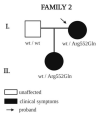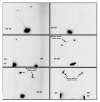Segregation Analysis of Rare NRP1 and NRP2 Variants in Families with Lymphedema
- PMID: 33212964
- PMCID: PMC7698471
- DOI: 10.3390/genes11111361
Segregation Analysis of Rare NRP1 and NRP2 Variants in Families with Lymphedema
Abstract
Neuropilins are transmembrane coreceptors expressed by endothelial cells and neurons. NRP1 and NRP2 bind a variety of ligands, by which they trigger cell signaling, and are important in the development of lymphatic valves and lymphatic capillaries, respectively. This study focuses on identifying rare variants in the NRP1 and NRP2 genes that could be linked to the development of lymphatic malformations in patients diagnosed with lymphedema. Two hundred and thirty-five Italian lymphedema patients, who tested negative for variants in known lymphedema genes, were screened for variants in NRP1 and NRP2. Two probands carried variants in NRP1 and four in NRP2. The variants of both genes segregated with lymphedema in familial cases. Although further functional and biochemical studies are needed to clarify their involvement with lymphedema and to associate NRP1 and NRP2 with lymphedema, we suggest that it is worthwhile also screening lymphedema patients for these two new candidate genes.
Keywords: NGS; NRP1; NRP2; genetic diagnostics; lymphedema.
Conflict of interest statement
The authors declare that they have no conflicts of interest.
Figures










Similar articles
-
Neuropilin-1 and neuropilin-2 act as coreceptors, potentiating proangiogenic activity.Blood. 2008 Feb 15;111(4):2036-45. doi: 10.1182/blood-2007-04-084269. Epub 2007 Dec 7. Blood. 2008. PMID: 18065694
-
Neuropilin-1 and neuropilin-2 are differentially expressed in human proteinuric nephropathies and cytokine-stimulated proximal tubular cells.Lab Invest. 2009 Nov;89(11):1304-16. doi: 10.1038/labinvest.2009.96. Epub 2009 Sep 7. Lab Invest. 2009. PMID: 19736548
-
Endothelial VEGFR Coreceptors Neuropilin-1 and Neuropilin-2 Are Essential for Tumor Angiogenesis.Cancer Res Commun. 2022 Dec 14;2(12):1626-1640. doi: 10.1158/2767-9764.CRC-22-0250. eCollection 2022 Dec. Cancer Res Commun. 2022. PMID: 36970722 Free PMC article.
-
Neuropilins in neoplasms: expression, regulation, and function.Exp Cell Res. 2006 Mar 10;312(5):584-93. doi: 10.1016/j.yexcr.2005.11.024. Epub 2006 Jan 27. Exp Cell Res. 2006. PMID: 16445911 Review.
-
The interaction of Neuropilin-1 and Neuropilin-2 with tyrosine-kinase receptors for VEGF.Adv Exp Med Biol. 2002;515:81-90. doi: 10.1007/978-1-4615-0119-0_7. Adv Exp Med Biol. 2002. PMID: 12613545 Review.
Cited by
-
Low Efficacy of Genetic Tests for the Diagnosis of Primary Lymphedema Prompts Novel Insights into the Underlying Molecular Pathways.Int J Mol Sci. 2022 Jul 3;23(13):7414. doi: 10.3390/ijms23137414. Int J Mol Sci. 2022. PMID: 35806420 Free PMC article.
-
Characteristics and advances in signaling pathways, cellular communication, cell junctions, and oxidative stress in lymphedema.Front Cell Dev Biol. 2025 Jul 22;13:1521320. doi: 10.3389/fcell.2025.1521320. eCollection 2025. Front Cell Dev Biol. 2025. PMID: 40766782 Free PMC article. Review.
References
-
- Gluzman-Poltorak Z., Cohen T., Herzog Y., Neufeld G. Neuropilin-2 and neuropilin-1 are receptors for the 165-amino acid form of vascular endothelial growth factor (VEGF) and of placenta growth factor-2, but only neuropilin-2 functions as a receptor for the 145-amino acid form of VEGF. J. Biol. Chem. 2000;275:18040–18045. doi: 10.1074/jbc.M909259199. - DOI - PubMed
Publication types
MeSH terms
Substances
LinkOut - more resources
Full Text Sources
Medical
Miscellaneous

